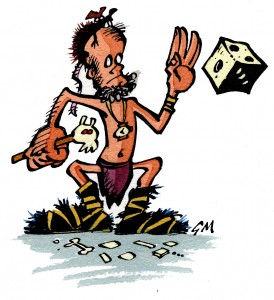
Une revue universitaire américaine (Analog Game Studies) m’a demandé de retravailler mon article sur “décoloniser Catan” pour en faire un essai plus long et un peu plus sérieusement argumenté. Ce post de blog reprend une annexe à cet essai, annexe consacrée aux problèmes rencontrés outre-Atlantique par les illustrations de deux de mes jeux, une sorte d’étude étude de cas sur la différence de perception, et donc de sens, de certaines représentations entre l’ancien et le nouveau monde. Il m’a semblé que la parution de Waka Tanka était une bonne occasion pour publier ce petit texte ici. Lorsque l’article complet sera publié en anglais, je posterai l’intégralité de sa traduction française.
À deux reprises, d’abord avec Isla Dorada, puis maintenant avec Waka Tanka, les illustrations réalisées en France pour mes jeux ont dû être modifiées par crainte qu’elles soient considérées comme racistes aux Etats-Unis. Mes amis de Days of Wonder ont aussi essuyé des critiques, assez puériles vues d’Europe, sur la présence d’esclaves dans Five Tribes, leur jeu sur les Mille et Une Nuits. Ce qui est intéressant ici, c’est de comprendre comment certaines images, ou certains thèmes, peuvent être perçus comme racistes aux Etats-Unis et pas en Europe, et parfois aussi l’inverse. Lorsqu’un tel problème se pose, et c’est fréquent dans de très nombreux domaines, les européens réagissent habituellement en se moquant de l’hypersensibilité et du politiquement-correct à l’américaine, tandis que les américains critiquent – à tort – l’insensibilité et l’aveuglement des européens et – parfois à raison – leur goût de la provocation. Un autre problème est que les américains sont habitués à voir les critiques du politiquement-correct venir d’une droite plus ou moins décomplexée, réclamant la liberté d’exprimer des idées socialement problématiques, et ne réalisent pas qu’en Europe les attaques viennent autant de la gauche, de tous ceux qui pensent comme moi que l’euphémisation du langage et des représentations est surtout une excuse pour ne pas s’occuper des vrais problèmes sociaux, voire un moyen de les cacher, et que la logique du politiquement correct finit par nuire aux bonnes causes qu’elle est censée défendre.
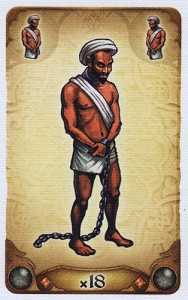
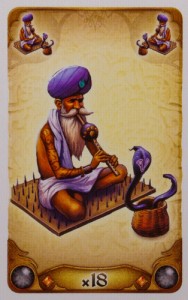
L’esclave et le fakir. Je reconnais que le dessin du fakir est meilleur.
Quoi qu’il en soit, et sans doute parce que je suis européen, je n’ai toujours pas vraiment compris quel problème posait la présence d’esclaves dans Five Tribes. Leur absence, voire leur occultation, dans Puerto Rico me met plus mal à l’aise. L’univers de Five Tribes relève de l’imaginaire orientaliste, celui de Puerto Rico est plus historique, mais les esclaves étaient présents dans ces deux mondes. Les remplacer par d’euphémistiques colons, ou par des fakirs quand il y a des centaines d’esclaves mais pas un seul fakir dans tout le texte des Mille-et-une-nuits, semble surtout un moyen d’ignorer, voire d’effacer, les passages les plus gênants de notre histoire. Cela ne contribue en rien à lutter contre l’orientalisme ou le racisme, cela n’aide pas non plus à les comprendre, cela les cache simplement d’une manière très superficielle et un peu hypocrite.
Ce qui m’est arrivé – ou, plus précisément, qui est arrivé à mes illustrateurs et mes éditeurs – est plus intéressant.
Isla Dorada est un compendium de clichés orientalistes sur diverses cultures, souvent allègrement mélangées. Tout dans son thème et ses illustrations relève de la caricature. Lorsque mes amis de Fantasy Flight Games prirent la décision de le publier en anglais, ils tiquèrent devant l’une des illustrations, le sauvage noir de la tribu des Ovetos, et demandèrent à l’éditeur français de la modifier car elle était, pour eux, à la limite du racisme. J’ai demandé le point de vue du seul auteur de jeu noir que je connaisse, Eric Lang, qui travaillait alors avec Fantasy Flight Games, et cette illustration ne lui posa aucun problème – mais il est aussi canadien, et donc à demi européen.
L’éditeur et l’illustrateur français réagirent de la manière habituelle « il n’y a rien de raciste, mais les américains sont un peu paranos sur ces questions, on va modifier le dessin ». Le problème de l’éditeur américain était que le cliché exploité par l’illustrateur n’était pas politiquement correct, le problème de l’illustrateur français était d’être fidèle à un cliché qui n’avait rien de politique, et qui était le véritable thème du jeu.
Là où les choses deviennent amusantes, c’est que nous nous sommes dans un premier temps trompés sur ce que les américains trouvaient raciste dans cette image. Nous avons pensé que c’était l’os qui traversait le nez du sauvage, alors que c’était ses lèvres proéminentes. Cela montre qu’une caricature n’est jamais raciste en elle-même. Nul ne fronça un sourcil lorsque le jeu fut publié outre-Atlantique avec un noir aux lèvres fines et au nez percé et décoré. Les codes définissant ce qui est raciste et ne l’est pas ne sont tout simplement pas les mêmes des deux côtés de l’océan. Pour nous, et pour moi, l’os, avec son côté “sauvage et barbare” était peut-être un peu limite, les lèvres, n’étant qu’un attribut physique, ne posaient pas plus de problème que des cheveux frisés – mais il est vrai que notre personnage est chauve.
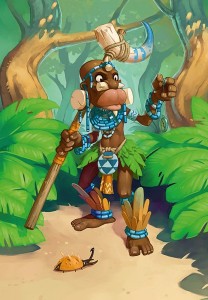
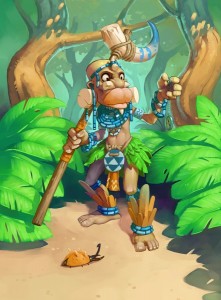
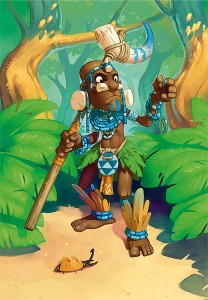
Trois versions successives de la carte Ovetos :
L’original, une première version rapidement corrigée avec des grosses lèvres mais la peau claire, et la version publiée, à laquelle les lèvres fines donnent un aspect cruel.
C’est un peu la même histoire qui est arrivée à Waka Tanka. Comme je l’ai expliqué précédemment, nous n’avons pas en Europe les mêmes complexes que les américains pour parler des indiens d’Amérique, un peu parce que, nous, nous ne leur avons rien fait mais surtout parce que l’image exotique que nous en avons est construite autant sur la similitude que sur l’étrangeté. Quoi qu’il en soit, un éditeur brésilien a décidé d’éditer ce jeu pour le marché américain. Il fut aussi surpris que moi, et que l’illustrateur, en apprenant que l’image de couverture risquait de passer pour une caricature ouvertement raciste. Bien sûr, nous nous sommes d’abord moqués du fait qu’il était impossible de dessiner un indien qui ressemble à un indien, mais après quelques discussions sur les forums de joueurs, il est apparu que le problème était, là encore, très spécifique. Ce n’était pas tant l’univers exotique des indiens des plaines, présent dans bien des jeux européens déjà vendus en Amérique, que la figure du vieux chef au premier plan, qui rappelait à tous les américains les « Cigar Store Indians », une image dont je ne connaissais que vaguement l’existence, mais qui est un peu l’équivalent américain de notre “noir banania”.
Pour les deux jeux, les premières discussions entre européens (et brésiliens) d’un côté, et américains de l’autre, ont consisté à argumenter, à expliquer que l’image était, ou n’était pas, raciste. Bien sûr, cela était vain, car la même image peut être raciste en Amérique et pas en Europe, selon les éléments de représentation qui sont devenus les codes arbitraires du discours raciste, et accessoirement selon le fait qu’une caricature est en elle même tenue ou non comme quelque chose d’insultant.
C’est pour cette raison que, même si cela coûte un petit peu plus cher, l’éditeur français de Waka Tanka a décidé de conserver la couverture initialement prévue pour l’Europe, et a demandé à l’illustrateur, David Cochard, d’en réaliser une autre pour les Etats-Unis. David s’est même fendu sur Facebook d’un petit billet d’humeur fort bien vu dans lequel il expliquait ce qu’est une caricature. Pour lui, comme d’ailleurs pour moi si j’avais su dessiner, ne pas être raciste consiste à caricaturer tout le monde de la même manière, tandis que refuser de caricaturer certains groupes aurait été à la fois raciste et paternaliste.


Les couvertures françaises et américaines de Waka Tanka
Nous avons aussi envisagé de déplacer l’action dans les îles du Pacifique, en remplaçant le totem par un tiki. Cela nous aurait permis, une fois le jeu publié sans que nul n’y trouve à redire, de faire remarquer ironiquement qu’alors qu’il y a plus de polynésiens que d’indiens d’Amérique, seuls ces derniers posent problème. Cela aurait cependant obligé à refaire toutes les illustrations et aurait donc coûté plus cher, et l’histoire des esprits animaux aurait moins collé à l’univers polynésien. Et puis, j’ai un autre jeu avec des tikis qui arrive bientôt, on va bien voir comment il sera reçu…. Il reste que, dans un monde ou les produits et les images sont mondialisés plus rapidement que les idées, ce genre de problème risque de se poser de plus en plus fréquemment.

A US academic review, Analog Game Studies, has asked me if I could expand on my post about “postocolonial Catan” to make a longer and more scholarly essay out of it. The new version of this articles, which develops some new themes, will be published in the second volume of the print edition of Analog Game Studies. The following post was originally intended as an annex about the problems we encountered in the US with the art for two of my games. It is a case study of the difference in the perception, and therefore in the meaning, of representations between the European and the American culture. I think that the publication of Waka Tanka, first in a French and in a few months in English, is a good oportunity to post this short text here,
Two times, with Isla Dorada and now with Waka Tanka, there has been problems with the graphics in my games, which had to be changed by fear that they would be considered racist in the US. My friends at Days of Wonder also experienced unexpected (and incomprehensible from Europe) attacks about the presence of slaves in their 1001 nights boardgame Five Tribes. I think there is something interesting in why some pictures or themes can be seen as racist in the US and not in Europe. When such an issue occurs, and it happens very often in various industries, the usual reaction on this side of the Atlantic is to mock American oversensibility and political-correctness, while the US point is to consider Europeans insensitive – which they are not – or provocative – which they might be. Another problem is that Americans are used to see attacks on political-correctness come mostly from the right, meaning from people who want the freedom to express problematic ideas, and don’t realize that many European attacks are coming from the left, from people who think, as I do, that euphemizing language or representation is mostly an excuse not to deal with “real world” social or racial issues, and even to hide them. As a result, undiscriminate political-correctness applied to language and representation ends up harming the very cause it was supposed to foster.


Slave and Fakir. At least, the art for the fakir is better.
Anyway, may be because I am a European, I still don’t really understand what exactly was the problem with the presence of slaves in Five Tribes and, as I wrote earlier, I find their absence in Puerto Rico much more unsettling. Five Tribes has a fantasy and extremely orientalist setting, Puerto Rico has a more historical one, but both settings include slaves, and replacing them with so-called “colonists” or with fakirs, when there are hundreds of slaves but not a single fakir in the whole text of the 10001 nights, looks like a way to simply ignore, to erase, the problematic parts of our history. It’s not getting rid of orientalism or racism, it’s not even helping to make sense of it, it’s just euphemizing them in a very superficial, and some would say hypocritical way.
What happened to me, or at least to my illustrators and publishers, with the graphics of two different games is more interesting.
Isla Dorada is a compendium of orientalist clichés from several different – and often lightly mixed – cultures. Everything in its theme and its graphics is caricature. When Fantasy Flight Games decided to publish it in the US, they frowned at one of the pictures, a black savage of the Ovetos tribe, and asked the French publisher to change it because it bordered on racism. Actually, the only black boardgame designer I know, Eric Lang, who was working with Fantasy Flight Games at that time, didn’t have any issue with picture, but he’s also a Canadian, which means half a European.
The French publisher, and the artist, reacted in the usual way “OK, it’s not racist, but Americans are a bit paranoid when it comes to these issues, let’s change it”. In fact, the problem for the US publisher was whether the cliché was politically acceptable, while the problem for the French artist was to be esthetically true to the cliché, which is the real theme of the game.
Where it becomes really fun, is that we first mistook what Americans thought racist in the picture – it was the fat lips of the character, when the artist first thought it was the bone through his nose. This shows that an exotic caricature is not racist per se – no one raised an eyelash when the game was published in the US with a thin lipped black tribesman sporting a bone through his nose – but that the codes defining what is racist and what isn’t are not the same in Europe and in the US. For us, and for me, the bone, which could suggest “cultural backwardness” was borderline, while the lips, being a physical feature, were no more problem than fuzzy hair – well, this Ovetos is actually bald, but you see what I mean.



Three versions of the Isla Dorada Ovetos card :
Naiiiade’s original, a first reworking with white skin, and the final version with black skin and thin lips. The thin lips make him look more cruel.
A very similar story happened with the cover art for Waka Tanka. As I said before, we don’t much care for stereotypes in the representations of American Indians in Europe. The main reason is not the obvious one, that we didn’t kill them – our cousins did – , it is that the exotic image we have of them is universally positive, and based as much on sameness than on otherness. Anyway, a Brazilian publisher decided to bring the game to the US, and was as surprised as me, the illustrator, and the French publisher when told the cover picture of the game was overtly racist. Of course, we first mocked the idea that it was impossible to draw an American Indian who looks like an American Indian, but after some discussions on game forums, it appeared that the issue was, once more, extremely specific. The problem was not the exotic and unrealistic setting, which is common in European games and didn’t create any problem so far, but the figure of the old chief in the foreground, which reminded every American of the “Cigar stores Indian” – an image I didn’t even know about.
For both games, the first steps in the discussion between European (and Brazilians) and Americans were trying to prove that the picture was, or wasn’t, racist. Of course, this was vain, since the answer is that the same picture can be racist in the US and not in Europe, or the reverse, depending on what part of the representation of the other has become the accepted sign of racism, and whether the very act of caricature is considered insulting or not.
It is to emphasize this that, even when it means some added costs, the French publisher of Waka-Tanka has decided to keep the original cover in Europe, while the artist, David Cochard, was commissioned a new one that will be used only in the US. David even wrote a fun and clever, but also a bit angry, reaction on Facebook in which he explained that he was a caricaturist, and that not being racist meant caricaturing everyone in the same way, while refusing to caricature some groups would have been both racist and patronizing.


The French and US covers for Waka Tanka
We also considered relocating the action in Polynesia, and replacing the totem with a tiki. This could have been fun in order, after the game had been published and raised no eyelash anywhere, to point at the irony that while there are far more Polynesians than American Indians, the latter were an issue and not the former. But changing all the graphics would have been expensive, and the animal spirit storyline would not have fitted as well in the new setting. And anyway, I have another game with tikis in the pipe, we’ll see what happens….. But, indeed, such issues will cause more and more problems in a world where products and images are globalized much faster than ideas.

Funny you mention Polynesians when it was a group of them that took Lego to court over the use of their legends in the bionicle. They won too!
Given the way you linked the two in the past was there any discussion of retheming to Gaulish druids? You grew up with Cowboy Luke, I grew up with Asterisk!
” un peu parce que, nous, nous ne leur avons rien fait”
Sérieusement ?
Et les premier génocides américains, ils ont été commis par qui ?
Notre faute est plus ancienne, c’est tout 😉
Pingback: New Game Round-up: Small Titles from Cool Mini Or Not, New Master Prints from Quined, and Smitten by Schotten Totten – Geek News
Pingback: Klischees töten
If someone tells you they find something offensive and you tell them they’re wrong, is that not the very definition of insensitive?
A quick Google image search of “Old Racist Comics” brings up images that bear a striking resemblance to the depiction on the Isla Dorada Ovetos card. I don’t know about Europe, but in the United States this imagery has been used for well over a hundred years to ridicule and marginalize a significant portion of the population. So it’s understandable that some might take offence to such a reference…even an accidental one.
In the states, we actually have a pretty robust ongoing dialogue about race relations so your changing the image on a card to be more sensitive isn’t going to stifle discussion in the slightest.
As a white, middle-aged, male, who resides in the United States, I’ve become aware that it’s not up to me to decide what is and isn’t offensive to others. It’s just up to me to decide if I care. Depening on the situation, I might not. But I need to own that choice.
It’s completely forgivable to accidentally offend someone out of ignorance. But to label something as “Politically Correct” when your attention is drawn to it, is to deny ownership. It’s lazy thinking.
Most of us are not politicians. We’re human beings. If you don’t want to offend someone, then don’t. If you have offended someone but didn’t mean to, say so and try to make amends. Otherwise, stand up and state that you’re fine with the offence and move on.
Well, we mad the change, but anyway that’s not the problem.
My main issues are
• The artist being accused of being deliberately racist (which is especially ironic here because he is half arab, or so I think) when he had no way of guessing what will be considered racist in the US. It’s as if americans think that everyone should have the same codes as them. This will probably happen, and it’s not necessarily a bad thing, but we’re not there yet.
• The focus on fighting harmless caricatures which, I think, is too often used to prevent people from fighting real social issues.
I couldn’t possibly speak for all americans but I, for one, don’t expect you to think and feel the same way I do. I recognize that everyone comes from a different place both geographically and metaphorically. I wouldn’t assume someone was racist simply because they were ignorant of a culture. It is their response to the criticism that would be telling.
In fct, there are plenty of americans who feel the same way you you seem to; who feel that “policial correctness” has gotten out of hand, as if they’re no longer free to express their opinion or their art. But this simply isn’t true. Everyone is still free to express what they want, when they want but they’re no longer free to do so in a vaccum.
If you want your game to focus on slavery, that’s fine. Some games do and they do it successfully. If you want your game to be taken seriously when its artwork emulates old racial stereotypes, go for it. But if you want to sell your game in a country whose populous sees these things in a bad light, it’s naive to think you can do so, successfully, without making accomodations.
Personally, I didn’t find the Five Tribes slave card to be offensive. But I do see how some people would feel uncomfortable trading human slaves as a currency. Some people find these themes to be deal breakers when it comes to recreational activities. If I were to sit down to play a game with someone who was seriously bothered by an element in that game, it would probably sour not only their opinion of the game but mine as well.
As for a caricature being harmless, I think this is still missing the point. To you or I, a single drawing might be harmless. But to someone else, it might mean something more. The Google image search I referenced represents a peek at a long history that accompanies such a caricature, whether intentional or not. It is near impossible to have an experieence or view an art piece and not reference earlier experiences or works. And when a person vocalizes their objection it doesn’t stifle discussion or stop people from “fighting real social issues”. In fact, it’s the only way to start.
Slavery isn’t seen as a real social issue (except to the slaves, of course) until people voice outrage against it. The same is true for sexism, nationalism, hunger, poverty, or anything else you can think of. None of it means anything if no one speaks up. Again, it’s up to each of us to decide if we care.
Truth be told, I probably wouldn’t have commented on this blog post had it not contained the phrase “Politically Correct”. If there was a phrase I could will out of existence it is that one. To me, when you place something in the “Politically Correct” or “Social Warrior” box, you become the one stifling discussion. You become the one stopping people from fighting real social issues. It’s a dismissive wave of the hand as if you can’t be bothered to investigate the issue because there obviously isn’t one. After all, you’d know it if there was, right?
This is the very attitude for which americans are accused of over and over. I, for one, take a kind of solace in the realization that the attitude is not confined to the borders of the United States of America; but is, instead, a world wide phenomena.
Anyway, I do thank you for the open discussion. It is important and I appreciate your very quick response.
“The artist being accused of being deliberately racist (which is especially ironic here because he is half arab, or so I think)”
Bruno, can you explain how anyone who isn’t white can’t be racist? We would really love to know why someone who is half-arab cannot be racist. I think this will definitely make clear your understanding of racism.
Of course it happens, but it’s more rare. In France Arabs are the main victims of racism and therefore quite careful about it.
Pingback: The Eleven Artists: David Cochard – Boards and Bees
Talk about dancing around the issue here. You say “esthetically true to the cliché”, but what you really mean is ‘stereotype’. Yes, you want to use stereotypes in your games not cliches…
I might not be as precise in English than in French. In my mind, and in French, a stereotype is something you think fits more or less with reality, a cliché something you know is just fantasy.
The pendulum has swung too far to the side of intolerance IMHO. Our 1st Amendment is there to protect speech, perhaps most importantly, speech with which others disagree. Otherwise, what is the point? Why protect speech you already agree with? But that Right places no burden on anyone else. No one is forced to print or broadcast your speech for you. If they were, that would make them a type of slave.
However, almost all manufacturers seeking to maximize sales internationally would do well to investigate ‘cultural sensitivities’. No one ‘forced’ the artwork changes on the designers, they were presented some facts, which may have been confusing or not, and took the advice to further promote the game’s sales.
There is an old movie, ‘Hallelujah I’m a Bum’ which had to have a title change for release in Great Britain to ‘Hallelujah I’m a Tramp’. They chose money over ‘artisitc integrity’ .
If your primary audience is yourself, your art can be anything so, express yourself. Your art could be for the recognition of peers or academia and you may receive honors. But, if it is aimed at the public-at-large you probably are trying to maximize profits in the marketplace.